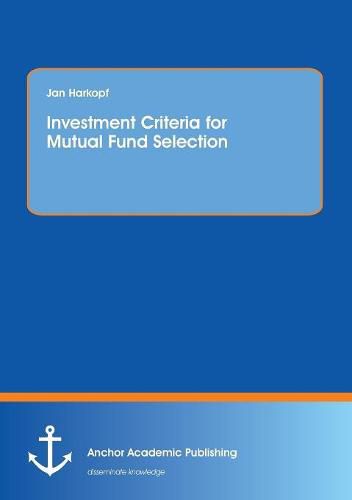Readings Newsletter
Become a Readings Member to make your shopping experience even easier.
Sign in or sign up for free!
You’re not far away from qualifying for FREE standard shipping within Australia
You’ve qualified for FREE standard shipping within Australia
The cart is loading…






This title is printed to order. This book may have been self-published. If so, we cannot guarantee the quality of the content. In the main most books will have gone through the editing process however some may not. We therefore suggest that you be aware of this before ordering this book. If in doubt check either the author or publisher’s details as we are unable to accept any returns unless they are faulty. Please contact us if you have any questions.
The importance of mutual funds for individual investors has increased in recent decades. This becomes apparent when looking at the increased share of households owning mutual funds. These mutual fund investors usually want to receive a return which is above or at least close to the mutual fund’s benchmark. Consequently, investors want to invest in those funds which will show these patterns in the future. Some of these mutual funds receive much attention, since they generate extraordinary high performance. But the question that remains is whether it is possible to predict such performance before funds exhibit such outstanding performance. In the past, mutual fund investors focused extensively on performance or performance linked patterns, like the Morningstar star rating, and thus chased past performance. This seems surprising since performance persists only over a short time and is more persistent to weak mutual funds (1 and 2 star rated) than well performing mutual funds. Thus, chasing past performances seems to be a rather inferior strategy. Therefore, investors should try to identify alternative tools showing a high correlation to future mutual fund performance. In this book, mutual funds are analysed, especially open-end mutual funds and actively managed mutual funds. The main focus is on what purpose and usefulness active investments have and whether performance is persistent and what the determinants of mutual fund flows are. Moreover, some alternative measures will be introduced by explaining which attributes or methods should be used and avoided when selecting mutual funds.
$9.00 standard shipping within Australia
FREE standard shipping within Australia for orders over $100.00
Express & International shipping calculated at checkout
This title is printed to order. This book may have been self-published. If so, we cannot guarantee the quality of the content. In the main most books will have gone through the editing process however some may not. We therefore suggest that you be aware of this before ordering this book. If in doubt check either the author or publisher’s details as we are unable to accept any returns unless they are faulty. Please contact us if you have any questions.
The importance of mutual funds for individual investors has increased in recent decades. This becomes apparent when looking at the increased share of households owning mutual funds. These mutual fund investors usually want to receive a return which is above or at least close to the mutual fund’s benchmark. Consequently, investors want to invest in those funds which will show these patterns in the future. Some of these mutual funds receive much attention, since they generate extraordinary high performance. But the question that remains is whether it is possible to predict such performance before funds exhibit such outstanding performance. In the past, mutual fund investors focused extensively on performance or performance linked patterns, like the Morningstar star rating, and thus chased past performance. This seems surprising since performance persists only over a short time and is more persistent to weak mutual funds (1 and 2 star rated) than well performing mutual funds. Thus, chasing past performances seems to be a rather inferior strategy. Therefore, investors should try to identify alternative tools showing a high correlation to future mutual fund performance. In this book, mutual funds are analysed, especially open-end mutual funds and actively managed mutual funds. The main focus is on what purpose and usefulness active investments have and whether performance is persistent and what the determinants of mutual fund flows are. Moreover, some alternative measures will be introduced by explaining which attributes or methods should be used and avoided when selecting mutual funds.